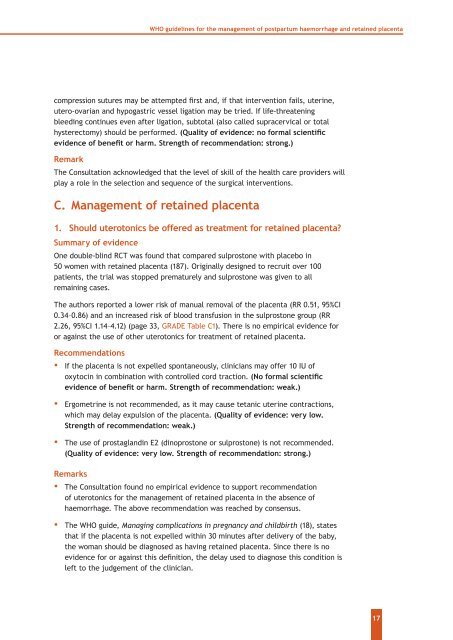WHO guidelines for the management of postpartum haemorrhage ...
WHO guidelines for the management of postpartum haemorrhage ...
WHO guidelines for the management of postpartum haemorrhage ...
Create successful ePaper yourself
Turn your PDF publications into a flip-book with our unique Google optimized e-Paper software.
<strong>WHO</strong> <strong>guidelines</strong> <strong>for</strong> <strong>the</strong> <strong>management</strong> <strong>of</strong> <strong>postpartum</strong> <strong>haemorrhage</strong> and retained placenta<br />
compression sutures may be attempted first and, if that intervention fails, uterine,<br />
utero-ovarian and hypogastric vessel ligation may be tried. If life-threatening<br />
bleeding continues even after ligation, subtotal (also called supracervical or total<br />
hysterectomy) should be per<strong>for</strong>med. (Quality <strong>of</strong> evidence: no <strong>for</strong>mal scientific<br />
evidence <strong>of</strong> benefit or harm. Strength <strong>of</strong> recommendation: strong.)<br />
Remark<br />
The Consultation acknowledged that <strong>the</strong> level <strong>of</strong> skill <strong>of</strong> <strong>the</strong> health care providers will<br />
play a role in <strong>the</strong> selection and sequence <strong>of</strong> <strong>the</strong> surgical interventions.<br />
C. Management <strong>of</strong> retained placenta<br />
1. Should uterotonics be <strong>of</strong>fered as treatment <strong>for</strong> retained placenta?<br />
Summary <strong>of</strong> evidence<br />
One double-blind RCT was found that compared sulprostone with placebo in<br />
50 women with retained placenta (187). Originally designed to recruit over 100<br />
patients, <strong>the</strong> trial was stopped prematurely and sulprostone was given to all<br />
remaining cases.<br />
The authors reported a lower risk <strong>of</strong> manual removal <strong>of</strong> <strong>the</strong> placenta (RR 0.51, 95%CI<br />
0.34–0.86) and an increased risk <strong>of</strong> blood transfusion in <strong>the</strong> sulprostone group (RR<br />
2.26, 95%CI 1.14–4.12) (page 33, GRADE Table C1). There is no empirical evidence <strong>for</strong><br />
or against <strong>the</strong> use <strong>of</strong> o<strong>the</strong>r uterotonics <strong>for</strong> treatment <strong>of</strong> retained placenta.<br />
Recommendations<br />
▪ If <strong>the</strong> placenta is not expelled spontaneously, clinicians may <strong>of</strong>fer 10 IU <strong>of</strong><br />
oxytocin in combination with controlled cord traction. (No <strong>for</strong>mal scientific<br />
evidence <strong>of</strong> benefit or harm. Strength <strong>of</strong> recommendation: weak.)<br />
▪ Ergometrine is not recommended, as it may cause tetanic uterine contractions,<br />
which may delay expulsion <strong>of</strong> <strong>the</strong> placenta. (Quality <strong>of</strong> evidence: very low.<br />
Strength <strong>of</strong> recommendation: weak.)<br />
▪ The use <strong>of</strong> prostaglandin E2 (dinoprostone or sulprostone) is not recommended.<br />
(Quality <strong>of</strong> evidence: very low. Strength <strong>of</strong> recommendation: strong.)<br />
Remarks<br />
▪ The Consultation found no empirical evidence to support recommendation<br />
<strong>of</strong> uterotonics <strong>for</strong> <strong>the</strong> <strong>management</strong> <strong>of</strong> retained placenta in <strong>the</strong> absence <strong>of</strong><br />
<strong>haemorrhage</strong>. The above recommendation was reached by consensus.<br />
▪ The <strong>WHO</strong> guide, Managing complications in pregnancy and childbirth (18), states<br />
that if <strong>the</strong> placenta is not expelled within 30 minutes after delivery <strong>of</strong> <strong>the</strong> baby,<br />
<strong>the</strong> woman should be diagnosed as having retained placenta. Since <strong>the</strong>re is no<br />
evidence <strong>for</strong> or against this definition, <strong>the</strong> delay used to diagnose this condition is<br />
left to <strong>the</strong> judgement <strong>of</strong> <strong>the</strong> clinician.<br />
17
















